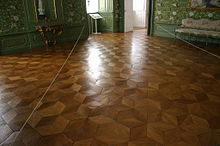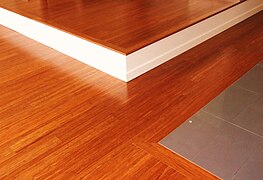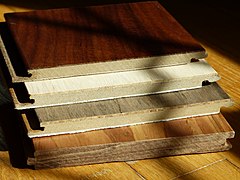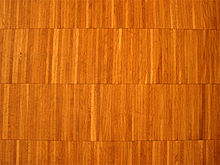parquet

Parquet is a floor covering made of wood or bamboo for rooms in closed buildings. The wood, usually hardwood from deciduous trees , is sawn into small pieces and put together according to certain patterns. Wooden floors where the annual rings are visible, d. H. the fibers are vertical, is called wooden plaster (wooden pavement). A large-format wooden floor made of long boards is called a plank floor . Parquet is considered to be a high-quality floor covering, because it is made up of small pieces of wood, in contrast to plank floors, it requires a stable sub-floor, but for the same reason counteracts the formation of joints. Its closed surfaces make it very hygienic.
material
Wood
Traditional European types of wood that are processed into parquet are mainly oak and beech. Non-European types of wood for parquet include teak / Burma, rosewood , Kambala , Afzelia (Doussie), Jatoba , Cabreuva , Eucalyptus , Mutenye, Bongossi / Azobe, Kosipo , Kotibe , Landa, Limbali , Louro vermelho , Peroba and others. They are all robust hardwoods . Wood-based materials are also used as a carrier for multi-layer parquet .
To distinguish from the floor is a laminate flooring . Laminate coverings consist of wood fiber as a carrier and are coated with melamine resin; the visible wooden surface consists of a laminated paper layer in a wood pattern (decorative layer impregnated with melamine resin). The laminate floors are laid in the same way as parquet. The plastic surface does not absorb moisture here, but moisture can be absorbed through the joints. For example, wet wiping can lead to irreversible swelling of the seams, rendering the floor covering unusable. Laminate is therefore usually cleaned dry to a maximum of slightly damp.
A parquet floor is more expensive than a laminate floor , but parquet can usually be renovated several times by sanding and sealing, which is not possible with laminate. In relation to a textile floor, parquet is a very durable floor covering. There are parquet floors in castles that are still attractive after centuries, but here most of the time expensive reconditioning of the parquet has taken place.
The hardness of parquet floors is generally specified in Brinell .
bamboo
Since the mid-1990s, bamboo, which is not wood in the strict sense of the word, but lignified grass, has been increasingly used for parquet floors. Because the material grows so quickly, bamboo parquet is many times cheaper than wooden parquet, but it only lasts 10-25 years, depending on the quality and load. The moisture tolerance and mold resistance is slightly higher than that of wood. Some products fade in strong sunlight. The laying is done either by nailing or by tongue and groove connections. Moso bamboo is harder than many types of wood (e.g. maple, oak). Naturally colored bamboo is harder than artificially darkened ( carbonized , carmelized ). The hardness of bamboo parquet, like that of wooden parquet, is determined using the Janka hardness test . Wet mopping leads to deformation of bamboo flooring, just like any other excessive exposure to water.
Since bamboo, unlike wood, does not grow in large, sawn trunks, it must always be heavily processed in order to get into board form. Depending on the manufacturing process, there are three types of bamboo flooring:
- Solid Bamboo - the cheapest type of bamboo flooring - is made from dried bamboo strips that are either folded horizontally or vertically, glued and then pressed into boards. Solid Bamboo and Engineered Bamboo not only contain adhesives, but also formaldehyde in small amounts .
- Engineered Bamboo is produced in a similar way to Solid Bamboo , but not made into solid boards, but glued onto plywood or chipboard like a veneer in 1 to 2 millimeters thickness .
- Strand Woven Bamboo ( Stranded Bamboo , Fossilized Bamboo ) is the most elaborate and therefore also the most expensive: The bamboo is frayed, freed from fragile fibers, crosswise rewoven, heated and pressed. The finished product no longer looks like bamboo but, depending on the processing, looks like wood or mottled fantasy wood, but is extremely hard and robust. The surface does not need to be sealed. If necessary, the parquet can be sanded like wooden parquet. Stranded Woven Bamboo mostly contains phenol formaldehyde , which is considered less toxic than formaldehyde.
Types of parquet
Solid parquet
Solid parquet consists of solid pieces of wood; A distinction is made between several types of construction: Solid parquet is usually laid raw and then sanded down with the parquet sanding machine in several sanding steps. The surface is then treated with parquet lacquer, floor oil or wax. The advancing technical development led to the production of calibrated solid parquet with surface treatments already applied in the factory. Solid parquet is currently also available as pre-fab parquet from some manufacturers. There is no need for grinding and finishing on the construction site.
Solid parquet, in particular mosaic, lamellar and lampar chains, but also wooden paving, were glued to cement or asphalt screeds with tar or bituminous adhesives in the 1950s to 1970s. These adhesives are often contaminated with carcinogenic PAHs ( polycyclic aromatic hydrocarbons ); dismantling and disposal of such parquet should only be carried out by specialist companies. A parquet glued in this way can become a potential source of danger, as the adhesive mass can be ground under the already loosened parquet parts and can get into the air and house dust via the joints in the parquet. The residents then ingest released PAHs through breathing air, food or through skin contact. Young children in particular are at risk if they play on the floor and inhale the dust that is blown up. Glue is suspect if its dark color indicates tar or bitumen components and the parquet was laid before the end of the 1970s. The adhesive should then be tested for PAH in a laboratory.
Strip parquet (solid parquet)
Strip parquet consists of individual pieces of wood (strips); traditionally mostly in the dimensions of 400–500 mm × 60–80 mm × 22 mm. But there are also thinner parquet strips and strips with a 2 or multi-layer structure (prefinished strip parquet). In the sides of a peripheral is groove milled into which a spring -called wood strip is inserted, thereby producing the bond between the individual boards. This shape of the parquet is the classic shape. It is nailed to the load-bearing wooden sub-floor, from the side diagonally by the tongue, so that the nail is covered by the neighboring parquet strip. Another name for this type of parquet is nail parquet (standard E DIN EN 13226). Parquet strips with a fixed, planed tongue or groove are also known as parquet belts. In the meantime, parquet rods are also often glued to the sub-floor, which results in a slightly better heat transfer with underfloor heating.
Mosaic parquet (solid parquet)
Mosaic parquet consists of smaller and, above all, thinner wooden slats with a thickness of 8 to 10 mm, usually glued to a mesh. Square slats with an edge length of 12 or 16 cm are installed as standard. The untreated parquet is sanded after gluing and the surface is varnished or oiled / waxed. Its low installation height is a great advantage with underfloor heating , as the heat transfer is little impeded. Even if another floor covering is to be replaced by parquet, the small thickness of the mosaic parquet is an advantage. Mosaic parquet is often used in an English association and in a parallel association.
Lamparquet (solid parquet)
Lamparquet is similar to strip parquet in its strip length from 120 to 400 mm and strip width from 40 to 65 mm, but it is only 10-11 mm thick. The laying and the properties are similar to the mosaic parquet (standard: solid wood lamp parquet according to E DIN 13227). It is also known as thin parquet or thin strip.
Lamellar parquet (solid parquet)
Edgewise lamellar parquet (HKL), like the mosaic parquet, consists of individual solid wood lamellas with a cross-section of usually approx. 8 mm × 22 mm. This parquet is a so-called residual product from the mosaic parquet production. The individual lamellas are arranged upright and held together in laying units by paper strips, plastic nets or adhesive tape. Due to the greater thickness of 22 mm, the parquet can be sanded more frequently and is therefore mainly used in the commercial sector. It is therefore also known as industrial parquet . Due to its popular look, upright lamella parquet has recently been used increasingly in living areas and in public facilities such as schools, museums and exhibition centers.
Nowadays, vertical lamellar parquet with a thickness of 10 mm is used more and more, and less often 16 mm.
Parquet flooring
Solid parquet strips are glued to form a board. Two or three parallel rows of bars are common. The boards are mostly 2–3 meters long.
Solid plank
Solid wood planks consist of one piece of wood (solid) and have a large format (at least 12 cm wide and 1.20 m long). If they are intended for fixation on the substructure, the thickness is usually 21 mm, but is also weaker if intended for flat bonding.
Panel parquet
Panel parquet is also called French parquet and is seen as the "queen of parquet floors". Geometric patterns are glued together to form square panels, such as diamonds and stars, in such a way that further complex patterns emerge. Different colored woods are often used. When designing the floor, the later use of the room is taken into account. A panel parquet floor with a surrounding frieze is often installed.
Multilayer parquet
The patent for the multi-layer parquet comes from Johann Kähr (Lamellenplatte) in 1939. In 1941, the Kährs company introduced the world's first “pre-fab parquet”. Due to its 3-layer structure, it has a higher resistance to warping and can therefore also be laid loosely, without full-surface gluing, often in a click system on an underlay mat. However, it can also be firmly glued without an underlay mat, which significantly improves the service life and the room noise behavior (by walking on, dropping objects, etc.), while the impact noise behavior is worsened (noise in rooms below and in adjoining rooms). Depending on the acoustic requirements, gluing can therefore be more or less recommended.
With the click systems a distinction is made between “force-locking” and “form-locking” systems. In the force-locking systems, the boards are connected by overcoming a resistance that subsequently holds the boards together, e.g. B. a small projection in the wood. Often with this method, the planks have to be tapped in vertically. The disadvantage of the system is that it often has to be glued or the small protrusions wear out, which leads to ugly joints. The form-locking system (Woodloc, lock-it, smart-lock etc.) is an angle system. Here the boards are angled into a CNC-milled shape from above.
The visible surface layer from the particular type of wood is often only 2 to 4 mm thick and glued to one or more carrier layers made of cheaper coniferous wood or to a carrier board made of wood-based material . In the case of multi-layers, the load capacity depends not only on the type of wood, but also on the overall structure, the thickness of the wear layer and the type and quality of the middle layer. Therefore, it is recommended to pay attention to the quality of the material.
These panels are fitted with tongue and groove that are incorporated into the softwood. There is no sanding after laying, since the individual elements are already sanded and surface treated. Small differences in height (<0.1 mm) between the individual elements are therefore not compensated for. Prefabricated parquet can easily be distinguished from ordinary parquet by looking at it against the light, whereby the individual elements show their flawless smoothness and sharp-edged borders. Multi-layer parquet can also be purchased in its raw state and then treated on site, which improves the quality and it can hardly be distinguished from solid parquet.
The service life of floating multi-layer parquet is not as long as that of glued parquet due to its ongoing mechanical load, because the tilting movements in the joints can lead to the ingress of water over time.
Decisive for the quality of multi-layer parquet is a) the quality of the surface varnish or the oil or wax (because this is where the load takes place and not on the wood), b) the quality of the plank connection and c) the use of high-quality techniques (e.g. . No "postage stamps", standing annual rings, lamellar side gluing).
As a variant of the multi-layer parquet there is, in addition to the three-layer parquet, also two-layer parquet . The first 2-layer prefabricated parquet was presented in 1975 by the Swiss company Bauwerk Parkett . The first 1-strip, 2-layer pre-fabricated parquet was developed by this manufacturer and the Italian company Margaritelli in the 1980s; the two companies had been fighting each other over the patent rights for years. This type of parquet has to be glued to the subfloor over the entire surface, which again increases the service life and can significantly improve the room noise. Two-layer parquet is available as a classic single strip (approx. 490 × 70 mm), ship floors and planks (lengths and widths different).
Laying pattern

|
Parallel bracing: The bars are laid in parallel at the same height.
|

|
Braided base: By attaching bars (2 to 4) parallel to one another and rotating such packages at right angles to one another, a braided look is created. Like cubes, only shifted towards each other.
|

|
Herringbone: Classic laying pattern with an interesting play of light. More suitable for large rooms.
|

|
Ladder floor: A row of bars lying parallel to each other alternates with a single row lying across.
|
See also the mathematical article tiling .
Trivia
In the United States, on September 4, 1883, the gramophone inventor Emil Berliner received a patent for a parquet floor designed according to his idea.
literature
- J. Barth et al .: Commentary on DIN 18 356 parquet work. Hamburg 2011.
- K. Remmert et al .: Textbook for parquet layers. 3rd edition Hamburg 2006.
Web links
Individual evidence
- ↑ Interesting facts about laminate ( Memento of the original from July 23, 2015 in the Internet Archive ) Info: The archive link was inserted automatically and has not yet been checked. Please check the original and archive link according to the instructions and then remove this notice. . Accessed May 6, 2015 (PDF)
- ↑ How is Bamboo Flooring Made. Retrieved February 28, 2020 .
- ↑ Understanding Solid and Engineered Bamboo Flooring. Retrieved February 28, 2020 .
- ↑ a b What Is Strand Woven Bamboo Flooring? Retrieved March 4, 2020 .
- ↑ Bamboo vs. Hardwood flooring. Retrieved February 27, 2020 .
- ↑ a b What is the difference between solid and engineered Bamboo flooring? Retrieved March 4, 2020 .
- ↑ a b Does Bamboo Flooring Contain Formaldehyde or Other Harmful Chemicals? Retrieved March 4, 2020 .
- ↑ US patent number 284,268 for Emil Berliner , accessed on April 20, 2010.








